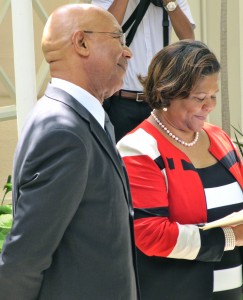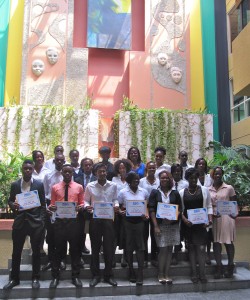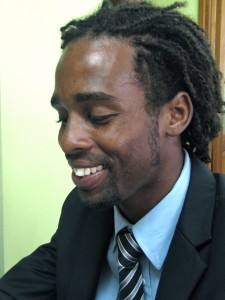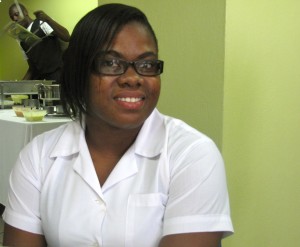
Telling our Jamaican Stories: The Art of Videography
September 16th, 2014
How important is it for young Jamaicans to tell their own stories, the stories that are true to them?
Young graduates from Phase Three Productions’ “Art of Videography” summer workshops are already starting to craft their individual narratives through the medium of film. The 18 – 25 year-olds were almost all hand-picked for the two free workshops offered to thirty young Jamaicans as part of Phase Three’s thirtieth anniversary celebrations. Last week, the group gathered at the Winchester Road office, all spruced up for a courtesy call with the Governor General, a tour of King’s House, and a wrap-up ceremony hosted by JAMPRO. All slightly nervous – including perhaps Dr. Marcia Forbes, Executive Chairman of Phase Three, who was anxious to get two busloads of excitable young people to King’s House on time.

Phase Three Productions Executive Chairman Marcia Forbes with Governor General Sir Patrick Allen at King’s House.
“I wish I were in your place,” Governor General Sir Patrick Allen told the group. The graduates were lined up in the Tea Garden, dappled with sunlight and shadows. Sir Patrick told them he would love to see through their eyes; to learn how they interpret what they see around them through the eyes of the camera. By the way, the program is endorsed under Sir Patrick’s “I Believe” initiative. Acknowledging the current “severe challenge” the Jamaican film industry is facing, JAMPRO Vice President Robert Scott said he sees young “film-makers” creating quality content that can be exported; and offering a skills base “right in Jamaica… There would be no need to bring in people to make a film here.”
For their final products, each workshop divided into groups of three. Each group produced a two-minute news feature and a two-minute mini-feature at Hope Gardens, with the assistance of three dynamic editors from Phase Three. At the graduation, we watched video excerpts from some of the students’ features. There was plenty of delightful scenery, of course – trickling water fountains, pots overflowing with bright flowers, manicured lawns and the lovely mountainous backdrop of Hope Gardens. This inspired a romantic mood for some of the features, with titles like “Chasing Butterflies.” The old, abandoned buildings tucked away in the wilder corners of the gardens made excellent settings for some fear, a touch of horror, even madness. The glimpses we saw of their work showed the remarkable range and creativity of the graduates.
After the speeches and the group photo-ops, the hungry students were treated to a delicious lunch by Phase Three, in JAMPRO’s very hospitable first floor venue.. I sat down with two of the graduates to talk to them about their workshop experience and their future plans. Jerome Marshall is a final year student at the Edna Manley College for the Visual and Performing Arts, where he is studying Visual Communications (which is graphic art) with a minor in Dance Composition. Quite a combination, and indeed Jerome has an all-embracing, inclusive view of the arts in general. He is busy arranging a transfer to the Art Institute of Philadelphia, where he plans to study Media and Animation – another indication of his holistic approach.
Since participating in the course, “I have started taking much more note of the aesthetics,” says Jerome Marshall. He watched the BET Video Music Awards recently with a more critical eye and was impressed by Beyoncé’s “Mine” video, which “channels” Michelangelo’s “Pietà” sculpture. [By the way, there is another interesting artistic reference in this video – “The Lovers” by René Magritte]. Jerome watches films with an eye for the directing – the role he would be interested in playing in film-making.
So now, what would Jerome Marshall like to do when he grows up? “Start my own performing arts company in Jamaica,” he replies, without hesitation.
Makeda Bawn came to the workshop with a love for still photography and the experience of the JN Foundation’s “Resolution Project” behind her. Now a sixth former and Vice President of the Photography Club at Glenmuir High School in Clarendon, Makeda tells me, “I have been taking photos since the age of seven.” She also writes poetry and prose. She wants Jamaican culture to be “revealed more” through her stories, which she has already been expressing eloquently through her photographs. Makeda won in the “Best Body Image” category at the Resolution Project Awards Ceremony in July this year, for a photograph entitled “Pure: Her Most Prominent Possession” (you can see this and other winning photographs on the Resolution Project’s Flickr page: https://www.flickr.com/photos/resolutionproject/sets/72157646188265539/)
Makeda’s Hope Gardens feature was, literally and figuratively, darker than the others we saw. She thought Hope Gardens’ pretty flowers and romance were “a bit of a cliché,” so chose a derelict building for her feature. She would like to be a Director of Photography, she told me. What genre would be of interest to her? (Personally, I think we have done enough Jamaican gangster films to last us for a while). “I’d like to make Jamaica’s first scary movie,” she says with a broad smile. “Something with duppies in it. Incorporating folktales, culture and history.” What kind of films does she enjoy herself? “Action and sci-fi.” A Jamaican sci-fi movie would be interesting, wouldn’t it?
Seventeen-year-old Naomi Redway, currently an upper-sixth form science major at Ardenne High School, says she is also “a proud graduate of Westwood High School for Girls.” Photography – street and human interest photography in particular – is a “huge” interest of hers. She currently writes and covers events for the Gleaner’s Youthlink publication. She is hoping to go into medicine, but… “Who knows what the future holds.”
The workshop was “an unbelievable experience,” Naomi enthuses, sparking her creativity and giving her an eye for detail. She had the chance to operate “fancy equipment” and meet the best in their profession. Most importantly, she adds, the training gave her “a new eye opening perspective on the world and how it is presented through film.” And what kind of stories should Jamaican film-makers be telling? Naomi thinks that crime and violence should take a back seat. She would like to see films exploring “the hidden beauty” of Jamaica; and, interestingly, what she calls “the mechanics of the Jamaican mind.” In other words, what it is to be Jamaican – what makes Jamaica, and Jamaicans,“special.”

The Gleaner YouthLink’s Naomi Redway was also a winner in the JN Foundation’s Resolution Project in 2013 and a graduate of Phase Three’s programme.
The students were full of praise for the workshop facilitators, all leading practitioners in their respective fields. At the graduation ceremony, the students greeted their names with whoops and cheers. It was obvious that presenters like Brian St. Juste – who has thirty years of producing and directing under his belt – thoroughly enjoyed the experience, too. The workshops were clearly a tremendous team effort, with the youthful, energetic staff at Phase Three providing moral and practical support, and Marcia Forbes taking a personal interest in the project from start to finish. JAMPRO’s Scott commended Dr. Forbes for her leadership. “It takes commitment, drive and caring,” he said. Dr. Forbes has all of that, in abundance.
Addressing the graduates at King’s House, Governor General Sir Patrick Allen asked a profound question (and I paraphrase a little here): When you are behind the camera, is the end result a “true reflection” of what you see before you?
Ah, that’s quite a question for our creative young people to tackle. Indeed, where is the truth of our Jamaican experience?
Tags: Brian St Juste, Edna Manley College for the Visual and Performing Arts, film-making, Glenmuir High School, Governor General, Hope Gardens, Jamaica, Jamaican, JAMPRO, JN Foundation, King's House, Marcia Forbes, Phase Three Productions, photography, Resolution Project, Robert Scott, Sir Patrick Allen, training, videography
The Gleaner reserves the right not to publish comments that may be deemed libelous, derogatory or indecent.
To respond to The Gleaner please use the feedback form.
- We Are the Zoomers
- Living Online with Humans and Birds: NAOC 2020
- Human Trafficking and the Problem of Public Education
- Down Memory Lane
- Are We Ready to Recover from COVID-19?
- Road Safety Matters: Is Your Vehicle Safe?
- Sexual Harassment, Me Too, and the Minister’s Disturbing Giggle
- The Vulnerable Senior Citizens, Private Care Homes and COVID-19
- A Muddle Over Masks
- Here is Something Life-Saving You Can Do: Give Blood!





